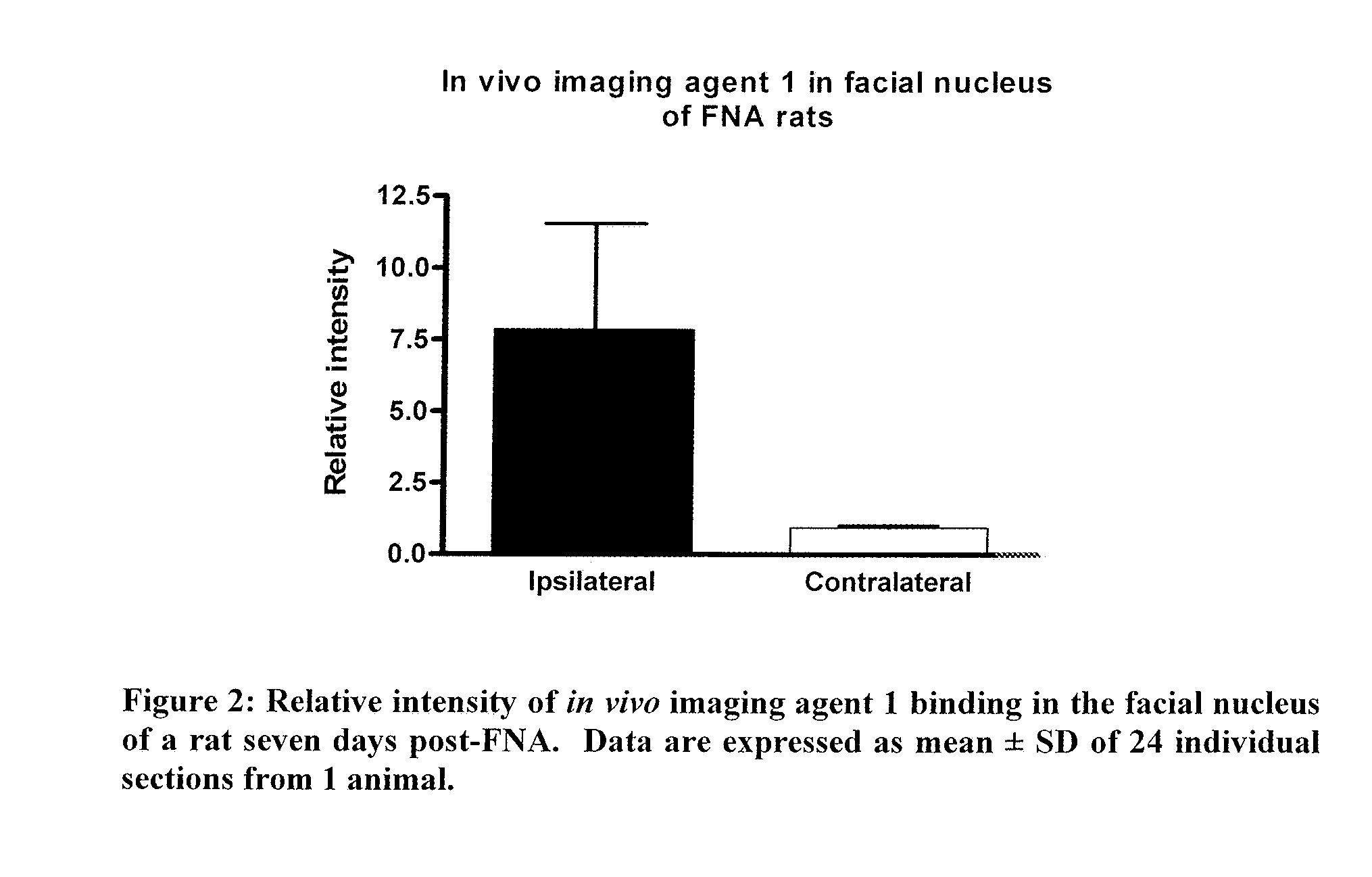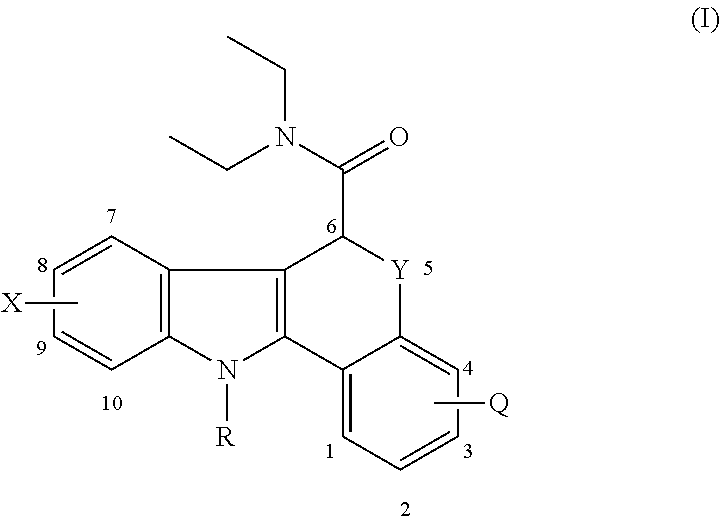Imaging neuroinflammation
a neuroinflammation and imaging technology, applied in the field of in vivo imaging, can solve the problems of complex modelling of quantification of binding, unsatisfactory kinetic properties of these compounds, and limitations, and achieve the effects of good brain uptake and in vivo kinetics, good binding properties, and good in vivo imaging
- Summary
- Abstract
- Description
- Claims
- Application Information
AI Technical Summary
Benefits of technology
Problems solved by technology
Method used
Image
Examples
example 1
Preparation of (+-)-11-(2-fluoroethyl)-8-methoxy-6,11-dihydro-5-thia-11-aza-benzo[a]fluorene-6-carboxylic acid diethyl amide (non-radioactive imaging agent 1)
Example 1(i). (+-)-4-Oxo-thiochroman-2-carboxylic acid diethyl amide
[0168]
[0169](+-)-4-Oxo-thiochroman-2-carboxylic acid (10.4 g, 50 mmol), prepared as described in T. Okubo et al (Bioorg. Med. Chem. 2004; 12: 3569-3580), in dry DCM (100 ml) was stirred under an atmosphere of nitrogen at room temperature with oxalyl chloride (12.6 g, 100 mmole) and one drop of DMF for 18 h. The reaction was then evaporated in vacuo to a gum and then redissolved in DCM (100 ml), cooled to 0° C. on an ice bath, stirred and treated dropwise with diethylamine (8.03 g, 110 mmol) in DCM (20 ml) over a period of 1 h. The reaction was allowed to warm to room temperature over 1 h and 10% aqueous potassium carbonate solution (100 ml) was added and the reaction mixture vigorously stirred. The DCM solution was separated. The aqueous solution was extracted ...
example 1 (
Example 1(iii). (+-)-11-(2-fluoroethyl)-8-methoxy-6,11-dihydro-5-thia-11-aza-benzo[a]fluorene-6-carboxylic acid diethyl amide
[0177]
[0178]To a solution of (+-)-8-methoxy-6,11-dihydro-5-thia-11-aza-benzo[a]fluorene-6-carboxylic acid diethyl amide (150 mg, 0.41 mmol; Example 1(ii)) in anhydrous DMF (4 ml) was added 2-fluoroethyl tosylate (166 mg, 0.82 mmol)), prepared as described in L. Cronin et al (J. Org. Chem. 2004; 69: 5934-5946) followed by sodium hydride 60% dispersion in mineral oil (34 mg, 0.82 mmol) under nitrogen. The reaction mixture was heated at 80° C. for 1 h. After cooling, the solvents were removed in vacuo, the residue quenched with water (30 ml), extracted with DCM (2×30 ml), dried (MgSO4) and solvents removed in vacuo. The residue was purified by column chromatography on silica, eluting with 5-10% EtOAc / CH2Cl2. The crude solid was quenched with ether / pet.spirit, filtered, dried in vacuo (45° C.) to give the title compound (77 mg, 46%) as a pale brown solid.
[0179]1H ...
example 2
Preparation of (+-)-11-(2-fluoroethyl)-10-methoxy-6,11-dihydro-5-thia-11-aza-benzo[a]fluorene-6-carboxylic acid diethyl amide (non-radioactive imaging agent 3)
Example 2(i): (+-)-10-methoxy-6,11-dihydro-5-thia-11-aza-benzo[a]fluorene-6-carboxylic acid diethyl amide
[0183]
[0184]This compound was prepared as described for Example 1(ii) except that 2-methoxyphenyl hydrazine hydrochloride was used instead of 4-methoxyphenyl hydrazine hydrochloride. The compound was obtained in 40% yield.
[0185]m / z (ES+) 367.0 (M+H).
PUM
| Property | Measurement | Unit |
|---|---|---|
| Force | aaaaa | aaaaa |
| Electric charge | aaaaa | aaaaa |
| Capacitance | aaaaa | aaaaa |
Abstract
Description
Claims
Application Information
 Login to View More
Login to View More - R&D
- Intellectual Property
- Life Sciences
- Materials
- Tech Scout
- Unparalleled Data Quality
- Higher Quality Content
- 60% Fewer Hallucinations
Browse by: Latest US Patents, China's latest patents, Technical Efficacy Thesaurus, Application Domain, Technology Topic, Popular Technical Reports.
© 2025 PatSnap. All rights reserved.Legal|Privacy policy|Modern Slavery Act Transparency Statement|Sitemap|About US| Contact US: help@patsnap.com



